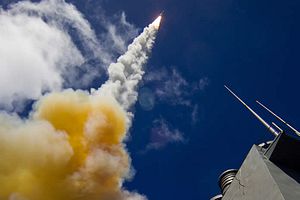The Japan Maritime Self-Defense Force (JMSDF), Republic of Korea Navy (ROKN), and U.S. Navy (USN) concluded a three-day naval exercise off the Korean peninsula on January 22, Yonhap News Agency reports.
The three-day naval exercise was kicked off on Friday, January 20 and involved three Aegis system-equipped guided missile destroyers. The so-called Aegis combat system is an automated command-and-control (C2) and weapons control system offering integrated air and missile defense capabilities to surface warships.
The aim of the military drill was to boost JMSDF, ROKN, and USN capabilities to detect and trace incoming North Korean missiles. The exercise comes amid steady advances in North Korea’s ballistic missile programs and growing signs that Pyongyang is ready to test-fire its first intercontinental ballistic missile.
The major emphasis of the missile defense drill was on the timely acquisition and sharing of data among the three navies. Similar to previous exercises a fighter jet stood in for the missile. According to a U.S. Naval Forces Korea spokesperson no missiles were fired from the Aegis-equipped ships.
“The U.S. Navy continually seeks every occasion to strengthen relationships and interoperability with participating allies and partners, while further developing maritime capabilities and capacity,” the spokesperson said in a statement quoted by Stars and Stripes on January 21.
According to Stars and Stripes, the JMSDF participated with the Kongo-class JS Kirishima guided missile destroyer, one of only six Aegis-equipped destroyers currently in service with the JMSDF. South Korea dispatched a Sejong the Great-class multi-purpose destroyer, and the United States sent the Arleigh Burke-class guided missile destroyer USS Stethem.
As I reported in August (See: “US to Upgrade Japanese and South Korean Destroyers With Latest Combat System”), the United States will upgrade two JMSDF Atago-class destroyers–improved variants of the Kongo-class —and three ROKN KDX-III Sejong the Great-class guided-missile destroyers with the latest variant of the Aegis combat system, which allows an Aegis warship to receive targeting information from a third party.
I explained:
The heart of the Aegis Combat System is the AN/SPY-1—“the Navy’s most advanced multi-function radar system,” according to Lockheed Martin. It is an advanced, automatic detect and track, multi-function phased-array radar system.
“This high-powered radar is able to perform search, track, and missile guidance functions simultaneously, with a track capacity of more than 100 targets,” according to the U.S. Navy. “When paired with the MK 41 Vertical Launching System, it is capable of delivering missiles for every mission and threat environment in naval warfare,” Lockheed Martin claims. This includes anti-air, anti-surface and anti-submarine warfare.
Aegis Baseline 9 offers a number of improvements from previous versions of the combat system. “The Aegis Combat System Baseline 9.C1 offers unprecedented capabilities, including simultaneous air and ballistic missile defense,” Sheridan, the Lockheed Martin director of Aegis programs, said in January. “This Aegis baseline also improves Aegis networking capabilities, allowing Aegis vessels to automatically coordinate defense with input from satellite and ground-based radar assets—forming a true shield of defense over a wide area.”
The Aegis combat system is compatible with Raytheon’s Standard Missile (SM) series. As The Diplomat reported, South Korea has expressed interest in acquiring the Standard Missile 3 (SM-3) capable of destroying short- to intermediate-range ballistic missile threats. The SM-3 is already in service with the JMSDF and U.S. Navy. Japan and South Korea may also be interested in acquiring the recently cleared for export Standard Missile 6 (SM-6), capable of intercepting ballistic missiles in their terminal stage of flight over land or sea.

































